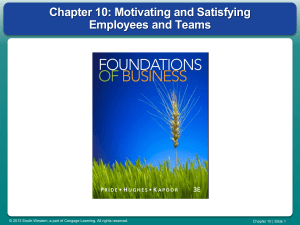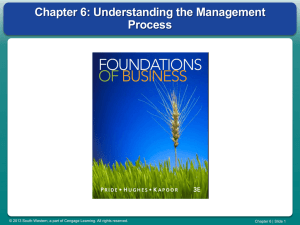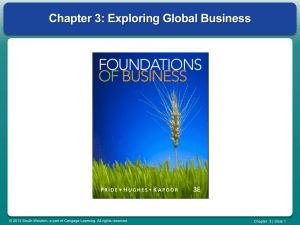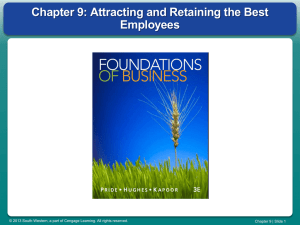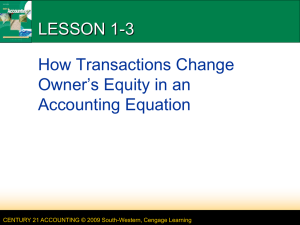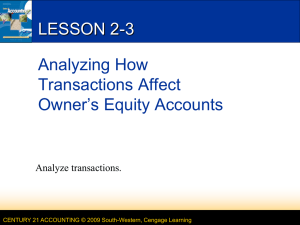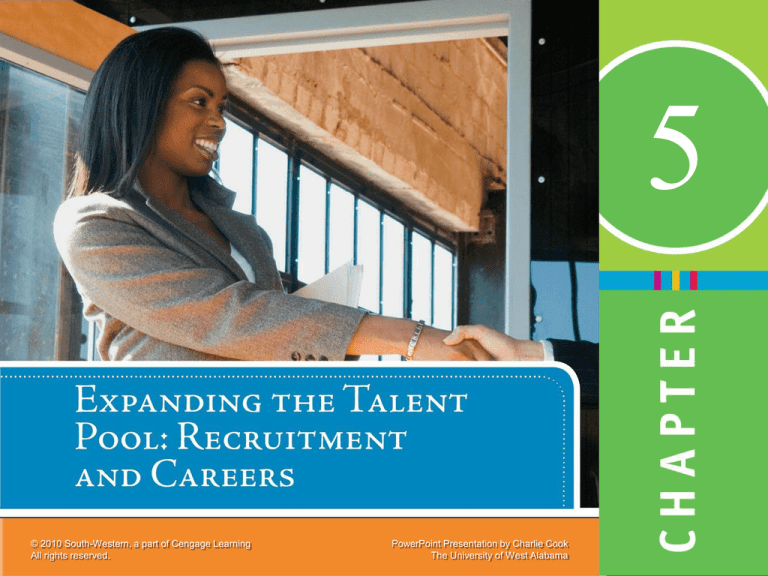
5
© 2010 South-Western, a part of Cengage Learning
All rights reserved.
PowerPoint Presentation by Charlie Cook
The University of West Alabama
X
Chapter Objectives
After studying this chapter, you should be able to
Explain the advantages and disadvantages of
external recruitment.
Explain the advantages and disadvantages of
recruiting from within the organization.
Discuss how job opportunities can be inventoried
and employee potential assessed.
Explain how career management programs
integrate the needs of individual employees and
their organizations.
Describe the conditions that help make a career
management program successful.
© 2010 South-Western, a part of Cengage Learning. All rights reserved.
5–2
X
Chapter Objectives (cont’d)
After studying this chapter, you should be able to
Explain why diverse recruitment and career
development activities are important to
companies.
© 2010 South-Western, a part of Cengage Learning. All rights reserved.
5–3
Recruiting Talent Externally
• Labor Market
Area from which applicants are to be recruited.
Tight market: high employment, few available workers
Loose market: low employment, many available
workers
• Factors determining the relevant labor market:
Skills and knowledge required for a job
Level of compensation offered for a job
Reluctance of job seekers to relocate
Ease of commuting to workplace
Location of job (urban or nonurban)
© 2010 South-Western, a part of Cengage Learning. All rights reserved.
5–4
1
Marriott’s Recruitment Principles
1. Get It Right the First Time
•
Hire friendly, train technical
2. Money Is a Big Thing, But . . .
•
Work-life balance, leadership, advancement
3. A Caring Workplace Is a Bottom-Line Issue
•
15 minutes/day reviewing basic values
4. Promote from Within
•
Passing soul of it’s business—corporate culture
5. Build the Employment Brand
•
Take care of associates and they will take care of
customers!
© 2010 South-Western, a part of Cengage Learning. All rights reserved.
5–5
Outside Sources of Recruitment
• Advertisements
• Labor unions
• Unsolicited applications and
resumes
• Public employment agencies
• Internet recruiting
• Private and temporary
employment agencies
• Employee referrals
• Employee leasing
• Executive search firms
• Educational institutions
• Professional associations
•Employers with great reputations don’t have to advertise much.
•In US, unemployed must apply for jobs every week to draw pay—
whether qualified or not.
•HR gets loads of resumes for every decent position.
© 2010 South-Western, a part of Cengage Learning. All rights reserved.
5–6
Increasing the Effectiveness
of Employee Referrals
Employee referrals is the most effective source for
recruitment (关系, guānxi, networking/relationships)
• Up the ante.
• Pay for performance.
• Tailor the program.
• Increase visibility.
• Keep the data.
• Rethink your taboos.
• Widen the program.
• Measure the results.
© 2010 South-Western, a part of Cengage Learning. All rights reserved.
5–7
FIGURE
5.1
Steps for Strengthening a Firm’s On-Campus
Recruiting Relationships
• Invite professors and advisers to visit your office and take them to
lunch.
• Invite them to bring a student group to the office.
• Send press releases and newsletters by mail or e-mail to bring them
up to date on the firm’s latest news and innovations.
• Provide guest speakers for classes.
• Conduct mock interviews, especially in years when not interviewing
for full-time or internship positions.
• Provide scholarships to students.
• Attend the campus career fair, even when the firm is not going to be
hiring, so that its name becomes known by the faculty and students.
• Offer job-shadowing programs for students.
• Provide tutors from your company.
© 2010 South-Western, a part of Cengage Learning. All rights reserved.
5–8
X FIGURE
5.2
Largest Temporary Help Agencies in the United States
© 2010 South-Western, a part of Cengage Learning. All rights reserved.
5–9
The Global Labor Market
• Why Recruit Globally?
To develop better products via a global workforce
To attract the best talent wherever it may be
• International Recruiting Issues
Local, national, and international laws
Different labor costs
Different preemployment and compensation practices
Cultural differences
Security
Visas and work permits
© 2010 South-Western, a part of Cengage Learning. All rights reserved.
5–10
X
Improving the Effectiveness of External
Recruitment
Calculate Yield Ratios
Training Recruiters
External
Recruitment
Realistic Job Previews
© 2010 South-Western, a part of Cengage Learning. All rights reserved.
5–11
External Recruitment Considerations
• Yield Ratio
Percentage of applicants from a recruitment source that
make it to the next stage of the selection process.
100 resumes received, 50 found acceptable = 50% yield.
• Cost of Recruitment (per employee hired)
SC AC AF RB NC
H
H
SC
AC
AF
RB
NC
H
= source cost
= advertising costs, total monthly expenditure (example: $32,000)
= agency fees, total for the month (example: $21,000)
= referral bonuses, total paid (example: $2,600)
= no-cost hires, walk-ins, nonprofit agencies, etc. (example: $0)
= total hires (example: 119)
Cost to hire one employee = $467.23
© 2010 South-Western, a part of Cengage Learning. All rights reserved.
5–12
External Recruitment Considerations (cont’d)
• Sources of Organizational Recruiters
Professional HR recruiters
HR generalists
Work team members
• Requirements for Effective Recruiters
Knowledge of the recruited job’s requirements and of
the organization
Training as an interviewer
Personable and competent to represent the
organization
© 2010 South-Western, a part of Cengage Learning. All rights reserved.
5–13
Improving the Effectiveness of External
Recruitment (cont’d)
• Realistic Job Previews (RJP)
Informing applicants about all aspects of the job, including
both its desirable and undesirable facets.
Positive benefits of RJP
Improved employee job satisfaction
Reduced voluntary turnover
Enhanced communication through honesty and openness
Realistic job expectations
In job interview, the organization is interviewing the
applicant, but the applicant should also be interviewing
the corporation—both directions looking for “fit”
© 2010 South-Western, a part of Cengage Learning. All rights reserved.
5–14
FIGURE
5.3
Warning Signs of a Weak Talent “Bench”
1.
It takes a long time to fill key positions.
2.
Key positions can be filled only by hiring from the outside.
3.
Vacancies in key positions cannot be filled with confidence in the
abilities of those chosen for them.
4.
Replacements for positions often are unsuccessful in performing
their new duties.
5.
Promotions are made on the basis of whim, favoritism, or
nepotism.
All of this may be caused by lack of initiative by the hiring
manager. No planning, no training, no mentoring, no
foresight, etc.
What do you do if you find two qualified people for critical jobs?
© 2010 South-Western, a part of Cengage Learning. All rights reserved.
5–15
Recruiting Talent Internally
• Advantages of a promotion-from-within policy:
Capitalizes on past investments (recruiting, selecting,
training, and developing) in current employees.
Rewards past performance and encourages continued
commitment to the organization.
Signals to employees that similar efforts by them will lead
to promotion.
Fosters advancement of members of protected classes
within an organization. (May be a huge legal advantage.)
Culture continuation.
© 2010 South-Western, a part of Cengage Learning. All rights reserved.
5–16
Recruiting Talent Internally (cont’d)
• Disadvantages of a promotion-from-within policy:
Current employees may lack the knowledge, experience or
skills needed for placement in the vacant/new position.
This is a hiring manager problem.
The hazards of inbreeding of ideas and attitudes
(“employee cloning”) increase when no outsiders are
considered for hiring.
Can be avoided by effective leaders and managers.
The organization has exhausted its supply of viable internal
candidates and must seek additional employees in the
external job market.
© 2010 South-Western, a part of Cengage Learning. All rights reserved.
5–17
Methods for Identifying Qualified Candidates
• Inventorying Management Talent
Information systems containing skills
inventories of employees that can be used:
To
screen candidates for an internal job opening
To predict career paths
To support succession planning
• Job Posting and Bidding
Posting vacancy notices and maintaining
lists of employees looking for upgraded
positions.
© 2010 South-Western, a part of Cengage Learning. All rights reserved.
5–18
Identifying Talent through Performance
Appraisals
• Managers are concerned about the actual current
performance and potential performance of employees.
• 9-box Grid
A comparative diagram that includes appraisal and
assessment data to allow managers to easily see an
employee’s actual and potential performance.
• Tough to do because performance appraisals are
rarely realistic.
Employees want to know how they did
Employers want to know how they will do in the future
© 2010 South-Western, a part of Cengage Learning. All rights reserved.
5–19
XFIGURE
5.4
An Example of a 9-Box Grid
© 2010 South-Western, a part of Cengage Learning. All rights reserved.
5–20
Using Assessment Centers
• Assessment Center
A process by which individuals are
evaluated as they participate in a series of
situations that resemble what they might be
called on to handle on the job.
In-basket exercises
Leaderless group discussions
Role playing
Behavioral interviews
© 2010 South-Western, a part of Cengage Learning. All rights reserved.
5–21
X
The Career Management Goal:
Matching Individual and Organizational Needs
The Employee’s Role
The Organization’s Role
Career
Management
Individual and
Organizational Goals
© 2010 South-Western, a part of Cengage Learning. All rights reserved.
5–22
XFIGURE
5.5
HR’s Role in Career Management
© 2010 South-Western, a part of Cengage Learning. All rights reserved.
5–23
The Organization’s Role:
Establishing a Favorable Career Development Climate
• Management
Participation
Provide top management
support
Provide collaboration
between line managers
and HR managers
Train management
personnel
Not designing career
plans for employees
© 2010 South-Western, a part of Cengage Learning. All rights reserved.
• Setting Goals
Plan human resources
strategy
• Changing HR Policies
Provide for job rotation
Provide outplacement
service
• Announcing the
Program
Explain its philosophy
5–24
FIGURE
5.6
Balancing Individual and Organizational Needs
“Linking” is probably a better word than
“Balancing”
© 2010 South-Western, a part of Cengage Learning. All rights reserved.
5–25
Identifying Career Opportunities and
Requirements
• Competency Analysis
Measures three basic competencies for each job:
know-how, problem solving, and accountability.
• Job Progressions
The hierarchy of jobs a new employee might
experience, ranging from a starting job to jobs that
require more knowledge and/or skill.
• Career Paths
Lines of advancement in an occupational field
within an organization.
© 2010 South-Western, a part of Cengage Learning. All rights reserved.
5–26
X FIGURE
5.7
Typical Line of Advancement in HR Management
© 2010 South-Western, a part of Cengage Learning. All rights reserved.
5–27
X
2
Career Path of Jeffrey Immelt, CEO, General Electric
1982
Enters GE’s Commercial Leadership Program
1983 Manager of Business Development/GTX Product Management, GE Plastics
1984
Manager of Dallas District Sales, GE Plastics
1986
General Manager of Western Region Sales, GE Plastics
1987
General Manager of New Business Development and Marketing Development, GE Plastics
1989
Vice President of Consumer Service, GE Appliances
1991
Vice President of Worldwide Marketing and Product Management, GE Appliances
1992
Vice President of Commercial Division, GE Plastics Americas
1993
Vice President and General Manager, GE Plastics Americas
1997
President and CEO, GE Medical Systems
2000
President, GE
2001
CEO, GE
© 2010 South-Western, a part of Cengage Learning. All rights reserved.
5–28
Recognize Lots of Possibilities for Career
Development
• Promotion
A change of assignment to a job at a higher level in the
organization.
Principal criteria for determining promotions are merit,
seniority, and potential. “Potential” should be far more
important than “merit” or “seniority.”
• Transfer
The placement of an individual in another job for which the
duties, responsibilities, status, and remuneration are
approximately equal to those of the previous job.
© 2010 South-Western, a part of Cengage Learning. All rights reserved.
5–29
Alternative Career Moves
Promotion
Exit
Career
Moves
Transfer
Demotion
All of these may be good for both the organization and the
individual depending on the long-term plan!
© 2010 South-Western, a part of Cengage Learning. All rights reserved.
5–30
Career Change Organizational Assistance
• Relocation services
Services provided to an employee who is
transferred to a new location:
Help in moving, in selling a home, in orienting to a new
culture, and/or in learning a new language.
• Outplacement services
Services provided by organizations to help
terminated employees find a new job.
How you treat displaced employees will have a
profound effect on those employees who remain.
© 2010 South-Western, a part of Cengage Learning. All rights reserved.
5–31
X FIGURE
5.8
Human Capital Profiles for Two Different Careers
© 2010 South-Western, a part of Cengage Learning. All rights reserved.
5–32
XFIGURE
5.9
Stages of Career Development
© 2010 South-Western, a part of Cengage Learning. All rights reserved.
5–33
The Plateauing Trap
• Career Plateau (高原, gāoyuán)
Situation in which for either organizational or personal
reasons the probability of moving up the career ladder is
low.
• Types of Plateaus
Structural plateau: end of advancement
Content plateau: lack of challenge
Life plateau: crisis of personal identity
• Managers must keep a close eye on productivity and
psychological impression on others of “plateaued”
employees!
© 2010 South-Western, a part of Cengage Learning. All rights reserved.
5–34
FIGURE
5.10
Career Plateau Questions
1. Do I accept high visibility assignments?
2. Do I continue to advance my education, both formal and
vocational?
3. Am I recognized by other leaders in my organization?
4. Am I routinely promoted?
5. Am I known as a versatile employee?
6. Do I continue to get larger-than-normal raises?
7. Do I rate at the high end of the performance ratings?
8. Do I have a plan with measurable objectives, and have I
updated it recently?
© 2010 South-Western, a part of Cengage Learning. All rights reserved.
5–35
Successful Career-Management Practices
•
•
•
•
Placing clear expectations on employees.
Giving employees the opportunity for transfer.
Providing a clear and thorough succession plan
Encouraging performance through rewards and
recognition.
• Giving employees the time and resources they need
to consider short- and long-term career goals.
• Encouraging employees to continually assess their
skills and career direction.
Who does this???
© 2010 South-Western, a part of Cengage Learning. All rights reserved.
5–36
Internal Barriers to Career Advancement
• Lack of time, budgets, and resources for
employees to plan their careers and to
undertake training and development.
• Rigid job specifications, lack of leadership
support for career management, and a shortterm focus.
• Lack of career opportunities and pathways
within the organization for employees.
© 2010 South-Western, a part of Cengage Learning. All rights reserved.
5–37
Career Development Initiatives:
Developing Talent over Time
• Career Planning Workbooks
Stimulate thinking about careers,
strengths/limitations, development needs
• Career Planning Workshops
Discuss and compare attitudes, concerns,
plans
• Career Counseling
Discuss job, career interests, goals
© 2010 South-Western, a part of Cengage Learning. All rights reserved.
5–38
Determining Individual Development Needs
• Fast-track Program
A program that encourages young managers with
high potential to remain with an organization by
enabling them to advance more rapidly than those
with less potential.
• Career Self-Management Training
Helping employees learn to continuously gather
feedback and information about their careers.
Encouraging them to prepare for mobility.
© 2010 South-Western, a part of Cengage Learning. All rights reserved.
5–39
Mentoring
• Mentors
Executives who coach, advise, and encourage individuals of lesser
rank. Often “grooming” for advancement.
• Mentoring functions
Functions concerned with the career advancement and psychological
aspects of the person being mentored.
• E-mentoring
Brings experienced business
professionals together with
individuals needing counseling.
• Official or unofficial
• Show reality of the organization.
• Tough on women.
© 2010 South-Western, a part of Cengage Learning. All rights reserved.
5–40
FIGURE
5.12
Mentoring Functions
© 2010 South-Western, a part of Cengage Learning. All rights reserved.
5–41
Forming a Mentoring Relationship
1. Research the mentor’s background.
2. Make contact with the mentor.
3. Request help on a particular matter.
4. Consider what you can offer in
exchange.
5. Arrange a meeting.
6. Follow up.
7. Ask to meet on an
ongoing basis.
© 2010 South-Western, a part of Cengage Learning. All rights reserved.
5–42
Career Networking Contacts
• Your college alumni association or career office networking
lists
• Your own extended family
• Your friends’ parents and other family members
• Your professors, advisors, coaches, tutors, clergy
• Your former bosses and your friends’ and family members’
bosses
• Members of clubs, religious groups, and other organizations to
which you belong
• All of the organizations near where you live or go to school
• (关系, guānxi, networking/relationship)
© 2010 South-Western, a part of Cengage Learning. All rights reserved.
5–43
Career Advice based on Luthans’ Research
Bert: “Successful” is not the same as “effective”. For promotion, it comes
down to who you know—networking (关系, guānxi).
Source: Based on F. Luthans, R.M. Hodgetts, and S.A. Rosenkrantz,
Real Managers (Cambridge, MA: Ballinger, 1988).
1–44
Developing a Diverse Talent Pool
• Recruiting and Developing Women
Growth of women in the workplace
Increase in females in management roles
Stereotyping and gender conflicts
• Recruitment of Minorities
Educational and societal disadvantages
Retention in organizations
Affirmative action
© 2010 South-Western, a part of Cengage Learning. All rights reserved.
5–45
Recruitment and Development of Women
• The “Glass Ceiling”
Artificial barriers based on attitudinal or organizational
bias that prevent qualified women from advancing upward
in their organizations into management level positions.
• Eliminating Women’s Barriers to Advancement
Development of women’s networks
Online e-mentoring for women
Diminishing stereotyping of women
Presence of women in significant managerial positions
Accommodating families
© 2010 South-Western, a part of Cengage Learning. All rights reserved.
5–46
International Push for Female Executives
• Norway—40% of board members in major companies are
women
Mandated by 2002 law
One study shows stock drop, but may be due to lack of experience
rather than gender
• Spain requires that by 2015 40% of board members be female
• Italy, France, and Belgium considering similar laws
• In US, only 15% of board members at top companies are
female
Studies show those companies are doing better
Unlikely to establish quotas
• 9.7% in European Union
• <5% in Asia
© 2010 South-Western, a part of Cengage Learning. All rights reserved.
5–47
Glass-Ceiling Audits
• Glass ceiling audit factors:
Upper-level management and executive training
Rotational assignments International assignments
Opportunities for promotion
Opportunities for executive development programs
at universities
Desirable compensation packages
Opportunities to participate on high-profile
project teams
Upper-level special assignments
© 2010 South-Western, a part of Cengage Learning. All rights reserved.
5–48
Recruiting and Developing of Minorities
• Career development for minorities is advanced by:
Organizational support for the
advancement of minorities to significant
management positions
Provision of internships to attract
minorities to management careers
Organization of training courses to foster
the development of minority’s managerial
skills and knowledge.
© 2010 South-Western, a part of Cengage Learning. All rights reserved.
5–49
Other Important Talent Concerns
• Recruitment of the Disabled
Increasing numbers of disabled in the workforce
Stereotyping of the disabled versus their superior
records for dependability, attendance, motivation
and performance
Accommodations for physical and mental
disabilities
Others with less publicized disadvantages
• Recruitment of Older People
Increasingly returning to the workplace
Have valued knowledge, experience, flexibility and
reliability as employees
© 2010 South-Western, a part of Cengage Learning. All rights reserved.
5–50
Dual-Career Couples
• Dual-Career Partnerships
Couples in which both
members follow their own
careers and actively support
each other’s career
development.
Flexible
work schedules
Adaptive leave policies
Work-at-home
On-premises day care
Job sharing
© 2010 South-Western, a part of Cengage Learning. All rights reserved.
5–51
Retention in China
• Employee turnover for international companies operating
in China is very high (20-30%)
No reason for loyalty to new companies
Opportunities are plentiful for trained, experienced
employees
• International companies need a good strong reputation as
great employers
Working environment, policy, and procedures
Internal promotions, professional career development
Pay and benefits
Values
© 2010 South-Western, a part of Cengage Learning. All rights reserved.
5–52
assessment center
mentors
career counseling
nepotism
career networking
9-box grid
career paths
outplacement services
career plateau
promotion
dual career partnerships
realistic job preview (RJP)
employee leasing
relocation services
fast-track program
transfer
job posting and bidding
yield ratio
job progressions
© 2010 South-Western, a part of Cengage Learning. All rights reserved.
5–53
Discussion Questions (page 234)
•#5 Why leave an organization for
career advancement?
•#7 Explain value of Realistic Job
Previews
•#8 What are advantages/disadvantages
of hiring internally?
© 2010 South-Western, a part of Cengage Learning. All rights reserved.
5–54
Case Study
•Page 236, #1 Nike Hiring
Technology
•Page 242, Caterpillar Career
Competencies
© 2010 South-Western, a part of Cengage Learning. All rights reserved.
5–55
Team Assignment (page 235)
•Interview each other on career
goals from early stages to present
then to future goals.
© 2010 South-Western, a part of Cengage Learning. All rights reserved.
5–56
X FIGURE
5.A1
© 2010 South-Western, a part of Cengage Learning. All rights reserved.
5–57
X FIGURE
5.A2
Twelve Steps for Starting a New Business
© 2010 South-Western, a part of Cengage Learning. All rights reserved.
5–58

